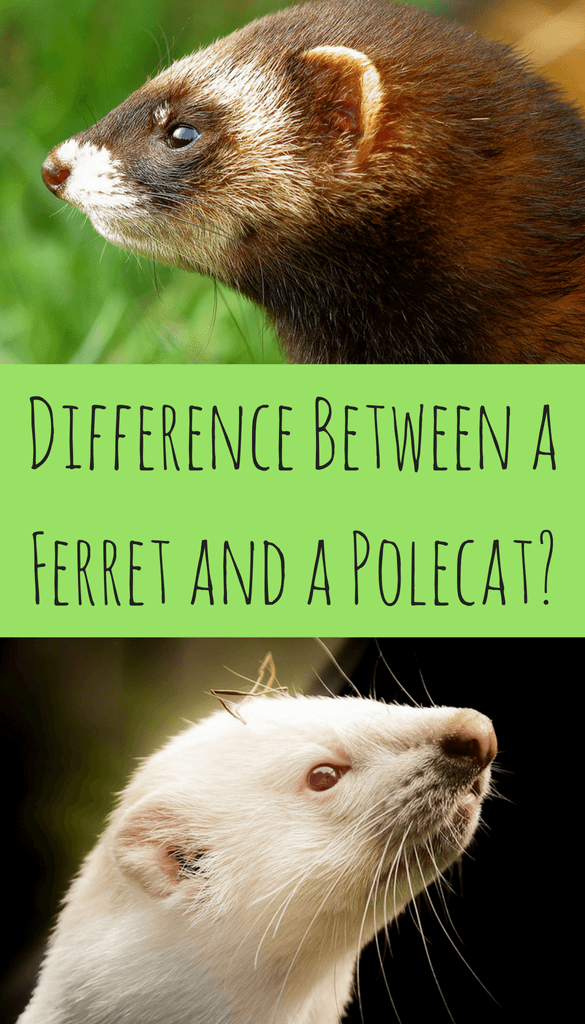What is the Difference Between a Ferret and a Polecat?
 History and Origins
History and Origins
Both ferrets and polecats belong to the weasel family. The European polecat can be found living in the wild in western Eurasia and north Morocco and now many are bred in captivity as a domesticated polecat. It is the sole ancestor of the domesticated ferret. They are thought to have been first domesticated some 2,500 years ago as aids for hunting rabbits.
Key Differences
In general, it can be incredibly difficult to easily tell these two very similar animals apart, given their very similar ancestry. However, there are some small differences. The main difference between polecat and ferret is:
Visual
- Polecats generally have larger heads (seen in males and females)
- The dark fur on the face of a polecat extends to the nose and does not in the ferret
- Ferrets tend to have a light patch of fur under their throat which isn’t seen in polecats
- Polecats have dark coloured paws whereas ferrets can have one or more white coloured paws
- Polecats have a more muscular, longer and leaner body shape
- Ferrets tend to have a longer bod
Behavioural
- Polecats prefer to lead solitary lives
- Ferret are much more sociable and enjoy the company of others (humans and ferrets alike!)
- Polecats secrete an pungent musky smell which can be an easy way to tell them apart
Cross Breeds
With many ferrets escaping or being abandoned, it won’t surprise you that a large proportion of ferrets live a feral existence. As a result there can be many ferret/polecat hybrids.
Which Makes the Best Pet?
As polecats tend to be less social and more solitary makes them less attractive as pets when compared with a ferret. However, both are suitable to keep as pets. If you would like to have more than one, then a ferret will be the best choice as they will happily live alongside other ferrets and indeed thrive in a group environment. If you are looking to just get a single ferret or polecat, opt for a polecat as this is their preference.
Care Needs
The care requirements of both ferrets and polecats are exactly the same as their needs are very similar.
Diet
Similar to cats, ferrets and polecats are carnivorous. In the wild they would eat small rodents, frogs and rabbits. They will eat raw and cooked meat such as chicken off the bone and they do love a raw egg on occasions! Most pet stores will also offer a range of dry and wet ferret food, which is important to ensure they are getting all of the essential nutrients that they would usually get from eating the whole carcass of an animal. You can of course buy whole animals from some reptile stores such as rats, mice and baby chicks so this is worth considering if you aren’t squeamish!
As very active animals, it is best to feed you ferret or polecat 2-4 small meals a day. This will help to maintain their high energy requirements!
They are generally quite fuzzy eaters so vary their food until you find something they will eat and stick with that. Do not feed your ferret or polecat fish based foods as it doesn’t agree with them.
Housing
In the wild, both polecats and ferrets live in underground burrows and above ground exploring for food. Therefore, any housing ideally needs to have two levels – a bottom compartment which is dark and full of hay for sleeping and a top section for climbing and play!
Provide tree branches, clay or plastic large piping and makeshift hammocks for them to explore and have some fun!
Ferrets also like to do their toilet in one area, so it can be useful to provide a litter tray which is easy to clean and empty.
Exercise
Both animals need stimulation in the form of exercise and play. You can purchase special harnesses and leads to take your ferret for walks or you can buy a play enclosure which can be separate or part of the housing. You can supervise your ferret off lead but do ensure it is an enclosed environment, free from potential risks – they are inquisitive and known for being escape artists so do be careful if you choose this option.

